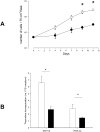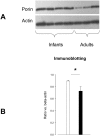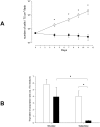An age-wise comparison of human airway smooth muscle proliferative capacity
- PMID: 25798916
- PMCID: PMC4370680
- DOI: 10.1371/journal.pone.0122446
An age-wise comparison of human airway smooth muscle proliferative capacity
Abstract
We compared the proliferation of neonatal and adult airway smooth muscle cells (ASMC) with no/moderate lung disease, in glucose- (energy production by glycolysis) or glucose-free medium (ATP production from mitochondrial oxidative phosphorylations only), in response to 10% fetal calf serum (FCS) and PDGF-AA. In the presence of glucose, cell counts were significantly greater in neonatal vs. adult ASMC. Similarly, neonatal ASMC DNA synthesis in 10% FCS and PDGF-AA, and [Ca2+]i responses in the presence of histamine were significantly enhanced vs. adults. In glucose-free medium, cell proliferation was preserved in neonatal cells, unlike in adult cells, with concomitant increased porin (an indicator of mitochondrial activity) protein expression. Compared to adults, stimulated neonatal human ASMC are in a rapid and robust proliferative phase and have the capacity to respond disproportionately under abnormal environmental conditions, through increased mitochondrial biogenesis and altered calcium homeostasis.
Conflict of interest statement
Figures




References
-
- Baraldi E, Filippone M. Chronic lung disease after premature birth. N Engl J Med. 2007;357:1946–55. - PubMed
-
- Halvorsen T, Skadberg BT, Eide GE, Roksund O, Aksnes L, Oymar K. Characteristics of asthma and airway hyper-responsiveness after premature birth. Pediatr Allergy Immunol. 2005;16:487–94. - PubMed
-
- Northway WH Jr, Moss RB, Carlisle KB, Parker BR, Popp RL, Pitlick PT, et al. Late pulmonary sequelae of bronchopulmonary dysplasia. N Engl J Med. 1990;323:1793–9. - PubMed
MeSH terms
Substances
LinkOut - more resources
Full Text Sources
Other Literature Sources
Miscellaneous

